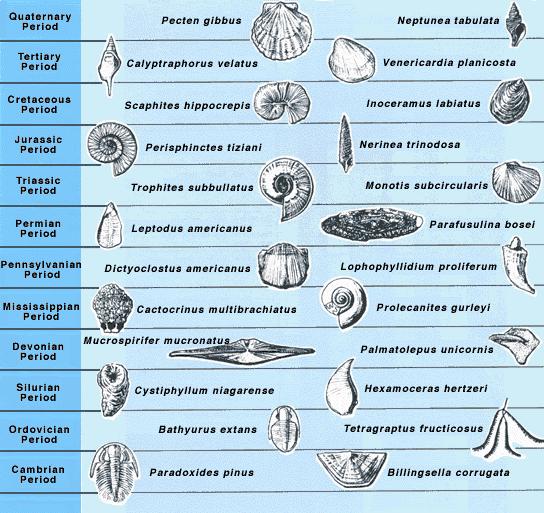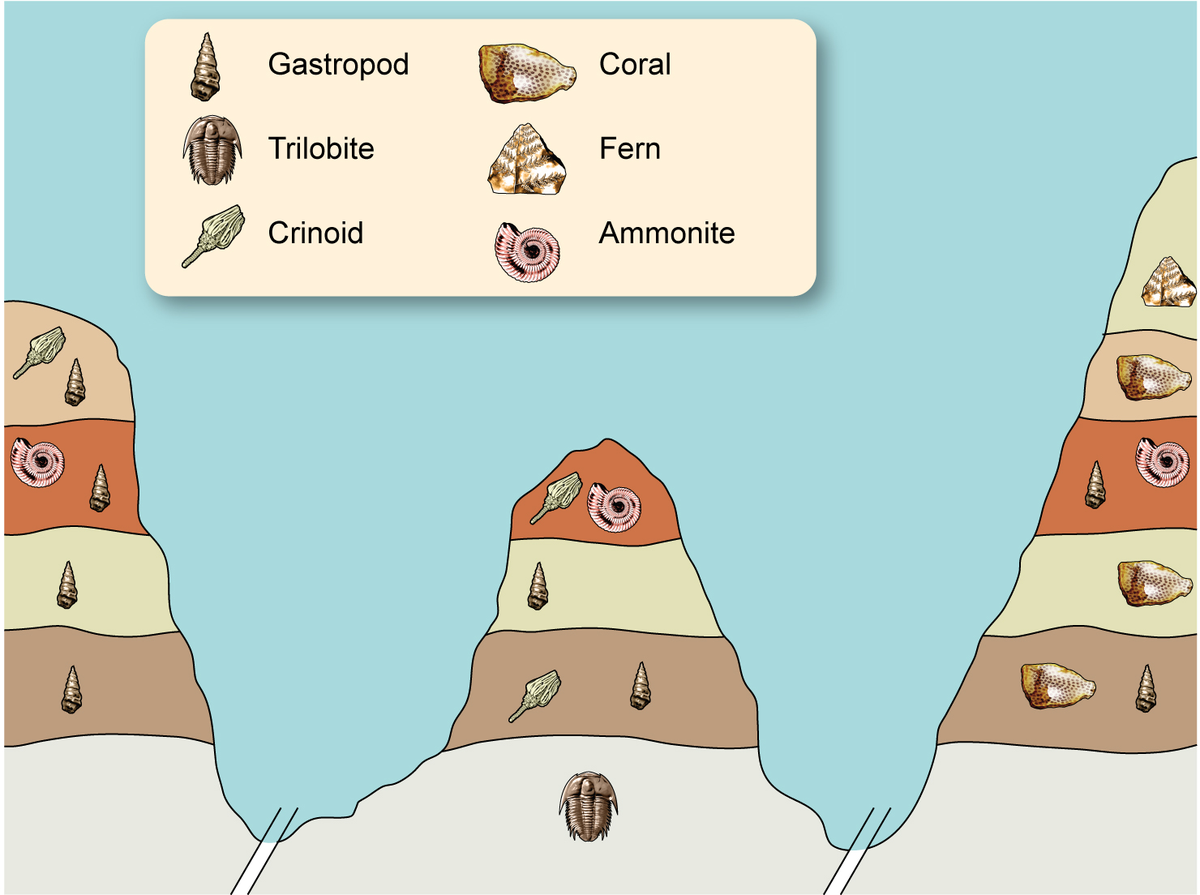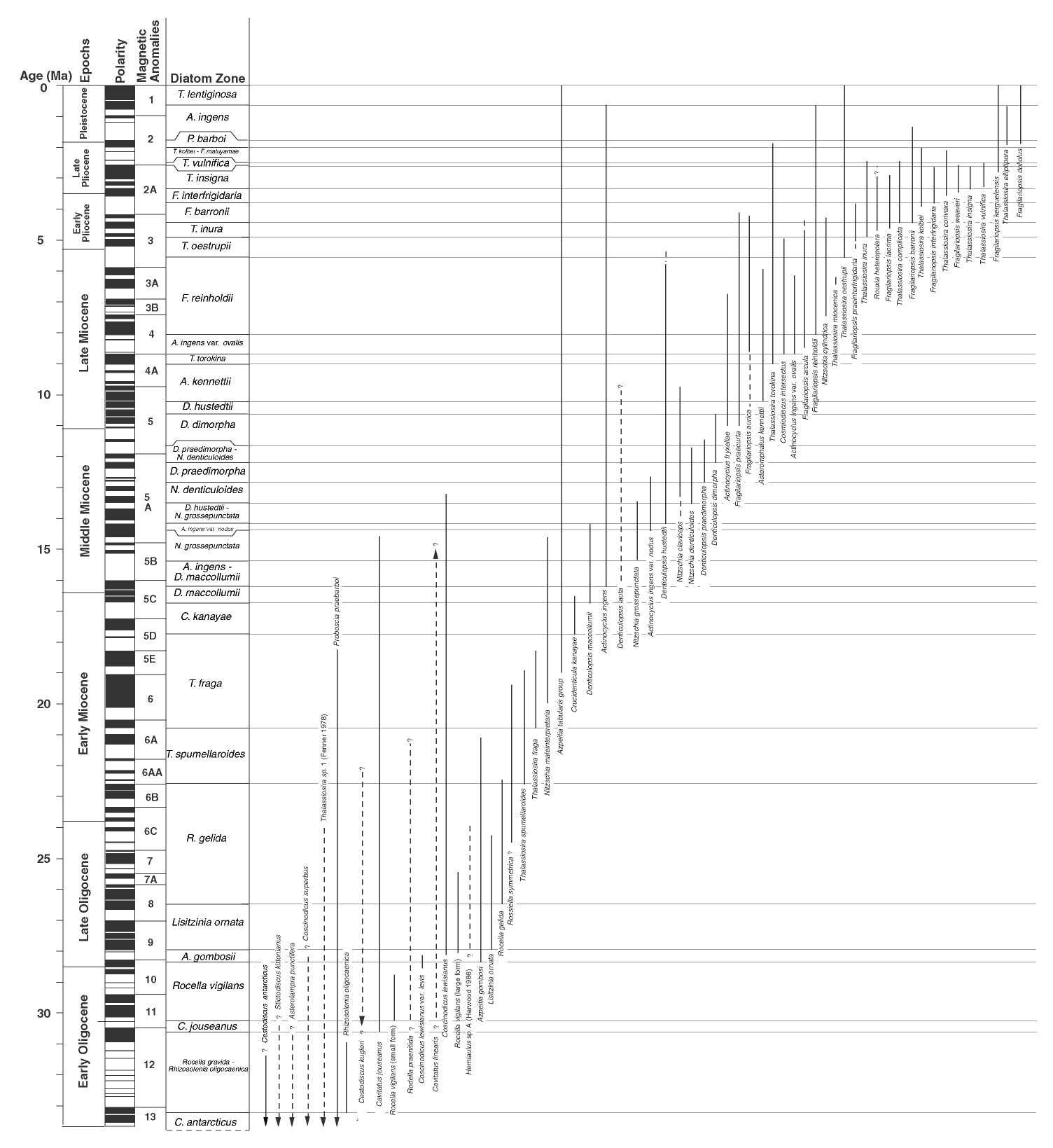Biostratigraphy – Biozones and Zone Fossils
- Page ID
- 10879
\( \newcommand{\vecs}[1]{\overset { \scriptstyle \rightharpoonup} {\mathbf{#1}} } \)
\( \newcommand{\vecd}[1]{\overset{-\!-\!\rightharpoonup}{\vphantom{a}\smash {#1}}} \)
\( \newcommand{\dsum}{\displaystyle\sum\limits} \)
\( \newcommand{\dint}{\displaystyle\int\limits} \)
\( \newcommand{\dlim}{\displaystyle\lim\limits} \)
\( \newcommand{\id}{\mathrm{id}}\) \( \newcommand{\Span}{\mathrm{span}}\)
( \newcommand{\kernel}{\mathrm{null}\,}\) \( \newcommand{\range}{\mathrm{range}\,}\)
\( \newcommand{\RealPart}{\mathrm{Re}}\) \( \newcommand{\ImaginaryPart}{\mathrm{Im}}\)
\( \newcommand{\Argument}{\mathrm{Arg}}\) \( \newcommand{\norm}[1]{\| #1 \|}\)
\( \newcommand{\inner}[2]{\langle #1, #2 \rangle}\)
\( \newcommand{\Span}{\mathrm{span}}\)
\( \newcommand{\id}{\mathrm{id}}\)
\( \newcommand{\Span}{\mathrm{span}}\)
\( \newcommand{\kernel}{\mathrm{null}\,}\)
\( \newcommand{\range}{\mathrm{range}\,}\)
\( \newcommand{\RealPart}{\mathrm{Re}}\)
\( \newcommand{\ImaginaryPart}{\mathrm{Im}}\)
\( \newcommand{\Argument}{\mathrm{Arg}}\)
\( \newcommand{\norm}[1]{\| #1 \|}\)
\( \newcommand{\inner}[2]{\langle #1, #2 \rangle}\)
\( \newcommand{\Span}{\mathrm{span}}\) \( \newcommand{\AA}{\unicode[.8,0]{x212B}}\)
\( \newcommand{\vectorA}[1]{\vec{#1}} % arrow\)
\( \newcommand{\vectorAt}[1]{\vec{\text{#1}}} % arrow\)
\( \newcommand{\vectorB}[1]{\overset { \scriptstyle \rightharpoonup} {\mathbf{#1}} } \)
\( \newcommand{\vectorC}[1]{\textbf{#1}} \)
\( \newcommand{\vectorD}[1]{\overrightarrow{#1}} \)
\( \newcommand{\vectorDt}[1]{\overrightarrow{\text{#1}}} \)
\( \newcommand{\vectE}[1]{\overset{-\!-\!\rightharpoonup}{\vphantom{a}\smash{\mathbf {#1}}}} \)
\( \newcommand{\vecs}[1]{\overset { \scriptstyle \rightharpoonup} {\mathbf{#1}} } \)
\( \newcommand{\vecd}[1]{\overset{-\!-\!\rightharpoonup}{\vphantom{a}\smash {#1}}} \)
\(\newcommand{\avec}{\mathbf a}\) \(\newcommand{\bvec}{\mathbf b}\) \(\newcommand{\cvec}{\mathbf c}\) \(\newcommand{\dvec}{\mathbf d}\) \(\newcommand{\dtil}{\widetilde{\mathbf d}}\) \(\newcommand{\evec}{\mathbf e}\) \(\newcommand{\fvec}{\mathbf f}\) \(\newcommand{\nvec}{\mathbf n}\) \(\newcommand{\pvec}{\mathbf p}\) \(\newcommand{\qvec}{\mathbf q}\) \(\newcommand{\svec}{\mathbf s}\) \(\newcommand{\tvec}{\mathbf t}\) \(\newcommand{\uvec}{\mathbf u}\) \(\newcommand{\vvec}{\mathbf v}\) \(\newcommand{\wvec}{\mathbf w}\) \(\newcommand{\xvec}{\mathbf x}\) \(\newcommand{\yvec}{\mathbf y}\) \(\newcommand{\zvec}{\mathbf z}\) \(\newcommand{\rvec}{\mathbf r}\) \(\newcommand{\mvec}{\mathbf m}\) \(\newcommand{\zerovec}{\mathbf 0}\) \(\newcommand{\onevec}{\mathbf 1}\) \(\newcommand{\real}{\mathbb R}\) \(\newcommand{\twovec}[2]{\left[\begin{array}{r}#1 \\ #2 \end{array}\right]}\) \(\newcommand{\ctwovec}[2]{\left[\begin{array}{c}#1 \\ #2 \end{array}\right]}\) \(\newcommand{\threevec}[3]{\left[\begin{array}{r}#1 \\ #2 \\ #3 \end{array}\right]}\) \(\newcommand{\cthreevec}[3]{\left[\begin{array}{c}#1 \\ #2 \\ #3 \end{array}\right]}\) \(\newcommand{\fourvec}[4]{\left[\begin{array}{r}#1 \\ #2 \\ #3 \\ #4 \end{array}\right]}\) \(\newcommand{\cfourvec}[4]{\left[\begin{array}{c}#1 \\ #2 \\ #3 \\ #4 \end{array}\right]}\) \(\newcommand{\fivevec}[5]{\left[\begin{array}{r}#1 \\ #2 \\ #3 \\ #4 \\ #5 \\ \end{array}\right]}\) \(\newcommand{\cfivevec}[5]{\left[\begin{array}{c}#1 \\ #2 \\ #3 \\ #4 \\ #5 \\ \end{array}\right]}\) \(\newcommand{\mattwo}[4]{\left[\begin{array}{rr}#1 \amp #2 \\ #3 \amp #4 \\ \end{array}\right]}\) \(\newcommand{\laspan}[1]{\text{Span}\{#1\}}\) \(\newcommand{\bcal}{\cal B}\) \(\newcommand{\ccal}{\cal C}\) \(\newcommand{\scal}{\cal S}\) \(\newcommand{\wcal}{\cal W}\) \(\newcommand{\ecal}{\cal E}\) \(\newcommand{\coords}[2]{\left\{#1\right\}_{#2}}\) \(\newcommand{\gray}[1]{\color{gray}{#1}}\) \(\newcommand{\lgray}[1]{\color{lightgray}{#1}}\) \(\newcommand{\rank}{\operatorname{rank}}\) \(\newcommand{\row}{\text{Row}}\) \(\newcommand{\col}{\text{Col}}\) \(\renewcommand{\row}{\text{Row}}\) \(\newcommand{\nul}{\text{Nul}}\) \(\newcommand{\var}{\text{Var}}\) \(\newcommand{\corr}{\text{corr}}\) \(\newcommand{\len}[1]{\left|#1\right|}\) \(\newcommand{\bbar}{\overline{\bvec}}\) \(\newcommand{\bhat}{\widehat{\bvec}}\) \(\newcommand{\bperp}{\bvec^\perp}\) \(\newcommand{\xhat}{\widehat{\xvec}}\) \(\newcommand{\vhat}{\widehat{\vvec}}\) \(\newcommand{\uhat}{\widehat{\uvec}}\) \(\newcommand{\what}{\widehat{\wvec}}\) \(\newcommand{\Sighat}{\widehat{\Sigma}}\) \(\newcommand{\lt}{<}\) \(\newcommand{\gt}{>}\) \(\newcommand{\amp}{&}\) \(\definecolor{fillinmathshade}{gray}{0.9}\)Colin Boisvert
Introduction
While specific minerals such as zircon or elements such as uranium, argon or strontium can provide a more precise geochronology value for a unit what if these elements/minerals are not detected in the rock? These minerals/elements are rare and often hard to find. Stratigraphy offers an alternative solution to radioactive minerals. Stratigraphy is the branch of geology concerned with the relative dating and sequence of rock units on the geologic timescale. This method is a relative dating method for rock units because while the Law of Superposition we can tell us undeformed layers further down are older than layers closer to the top, we don't how the exact age difference. Interpreting stratigraphy can be difficult due to geologic processes such as folding,faulting and unconformities which deform the stratigraphy in a region.Scientists use a variety of different branches of stratigraphy with different methods to date strata units.So what about fossils discovered in the stratigraphic layers? Finding fossils in Phanerozoic strata is relatively easy to do and scientists can use the relative age of fossils in the rock layers to build the geological time scale. Biostratigraphy is the branch of stratigraphy that uses widespread, quick evolving and well-studied fossils found in the rocks to date strata. It is a very helpful tool for scientists to build and modify the geological timescale!
So what is Biostratigraphy?
Biostratigraphy is the specific branch of stratigraphy that uses index fossils found in the strata to serve as biological markers and give a more precise estimate of the rock unit's age. Index fossils are fossils found in stratigraphic units that meet a set of criteria that allows us to date the stratigraphic unit rock to a range because of the animal's evolutionary and geologic record. Since an index fossil is unique and found only during a certain span of time, finding a specific index fossil in the strata provides a small span of time that we can date this unit to. When we find the same index fossil in stratigraphic units located far apart, we can use chronostratigraphy to correlate these units to the same age because they both contain the same index fossil. Chronostratigraphy studies the age of rock units relative to time so discovering the same index fossil pinpoints the age of two different rock units because of the same index fossil found in both.

Biostratigraphy is an extremely powerful tool for chronostratigraphic correlation. Life evolves through time, with new species emerging and other species going extinct. For time intervals and species that are well studied, the process of evolution provides a detailed temporal framework for correlating stratigraphic columns. The basic idea is for the geologist to identify a fossil's biozone. This is done by identifying the fossil species in the stratigraphic columns, compare them to the known age ranges of those species , and then constraining the age of the rocks from documented extinction and origination events of the identified species. This is an extremely powerful approach to correlating stratigraphic columns because each species is unique and changes through time. Magnetostratigraphy,another branch of stratigraphy that uses polarity switches recorded in the rock record to date strata units is often connected with biostratigraphy as seen in figure 3.

Biozones are zones of well-documented fossil species with distinct origination and extinction times. Specific biozones can be defined a number of ways:
- The total time of a fossil's existence.
- It could consist of the total time where two or more fossils coexist.
- It could be defined as the time between the origination of one fossil and the extinction of a different fossil, etc.
An example of a biozone chart, combined with magnetostratigraphic reversals can be found at: http://www-odp.tamu.edu/publications/189_IR/chap_02/c2_f6.htm

Criteria for a good index fossil vs a bad one?
There are 4 main criteria that all have to be met for an organism to be considered a good index fossil.
- Have short geological ranges, e.g. they did not live for millions of years, and evolved quickly; Quick evolution means scientists can track the morphological changes in a species. When a species evolves into a new species , scientists can use this information to build the timescale for that specific species as an index fossil. If we can track the evolution from species to species then we can easily pinpoint the beginning and end of one species and the transition to a new one . This combination allows us to identify an index fossil in the strata and have a more precise idea of what window of time we are looking at for the age of the rock unit.
- Distribution over a large region of the earth; Since most of the Earth is covered in water it is easier for a marine fossil to be considered an index fossil vs land fossils which can be restricted to one continent usually.Oceans have risen and fallen with as much as 85% percent of the planet covered by the sea making it easier to find marine fossils. Since marine animals could more easily spread over a large portion of the globe, this helps with the potential for burial in marine strata millions of years later.On land an animal is more restricted in how far a species can spread so this makes it easier for marine animals to be classified as index fossils.
- Easily preserved and abundant; Hard parts, such as bones, shells, or exoskeletons, are more easily preserved in sediment because they are not subject to erosion and decay in the way that soft tissues are. Because hard parts can still be eroded through weathering, some of those hard parts will have a better chance of preservation if a high number of them are buried.
- Sufficiently studied; Fossils that aren't well-studied do not make good index fossils because we do not know enough about their evolutionary histories or over what time span they existed. With well-studied fossils, we do have this information and understand that the presence of a certain fossil signals a particular time range. For example, ammonites and trilobites are well-studied with specific age ranges so it is easy to use them as index fossils.
Reasons Why your favorite dinosaur Tyrannosaurus rex is not a good index fossil
Your Favorite Dinosaurian predator is not a good index fossil because while it is well-studied and its bones are easily preserved, it only lived in Western North America (Limited range over the Earth) and it lived for around 2-3 million years and it did not evolve quickly. Most dinosaurs in fact are not good index fossils because of their restricted geographical range , slow evolution and limited knowledge.
In fact, many tetrapod macrofossils that people know are not good index fossils because they do not fit one of the four criteria. If an organism is only found in one region, such as dire wolves in North America, or contains mostly soft parts like cartilage in most sharks fossils, then this makes them a poor candidate for an index fossil. Furthermore, if the organism has a long geological range or are rare fossils and not well studied this makes the species a poor candidate for being an index fossil as well. Fossils that contain a lot of soft parts, single species that lived for long periods of time,were endemic to a specific region or are rare in the field today are criteria for being a poor index fossil that should not be used. This would make using living fossils like the Coelacanth difficult to use as well as many living fossils have few fossils but ancient lineages making it seem like one species lived for a long time which is a criteria for being a poor index fossil. All together, if you see a shark tooth,Tyrannosaurus femur, and an ammonite shell in the strata unit you are studying, pick the ammonite for biostratigraphic purposes.
Index fossils of the Phanerozoic
Common examples of index fossils include:
Phanerozoic: Foraminfera (542-0 million years ago) Forams are an extant group of organisms withnumerous species that are well studied, have short temorpal ranges and are widespread. Since we find forams all over the place their evolution is well studied and their record of 18O means we can use them for stable isotpe studies with paleoclimates and as an index fossil.
Paleozoic:Trilobites (542-252 million years ago) Trilobites are a numerous group of marine arthropods with correlated species temporal ranges allowing for specific chronostratigraphic correlation based on specific index fossils of trilobites. Specific examples include Paradoxides as stated in Figure 1 which was a genus of Trilobite that contained 19 species that lived during the Mid-Late Cambrian Period. Species of this genus have been found up and down both sides of the Atlantic Coastline from Canada to Africa. All together these 19 species provide a temporal range from 514-497ma .Another genus example includes Phacops.
_1_(15161039897).jpg?revision=1&size=bestfit&width=557&height=406)
Mesozoic:Ammonites (252-66 million years ago) Once again this group of cephalopods was a prosperous marine group that thrived during the Mesozoic and this prosperity means we can follow the evolution of different species to help constrain certain species to different stages of the Mesozoic. This combined with their geographic range makes them a great index fossil. An example genera is Perisphinctes with 4 species covering the Middle-Late Jurassic epoch.
.jpg?revision=2&size=bestfit&width=415&height=311)
Cenozoic: Diatoms (66-0 million years ago) This marine group also has a numerous amount of species that lived over short temporal ranges.

Case study: Using index fossils to date rocks in India
In India, specifically the Triassic Spiti Basin, Jurassic Kachchh Basin, and Cretaceous Kachchh and Cauvery Basins, scientists used mainly Ammonoid Biostratigraphy coupled with biozones to help correlate and date the regions for a more precise chronostratigrpahic correlation of these basins in India during the Mesozoic (Krishna,2017). Scientists were unclear on how the basins formed and wished to accurately date the regions and start of the geologic events.
Ammonites are aquatic molluscs meaning wherever we find their fossils we can correlate this strata to an aquatic paleoenviornment. As for all the layers deposited in the sea, scientists examined these layers of rock to search for species of ammonites. When one was found it was identified by species and using the range of time for the known species, the scientists refined the strata into the relevant temporal stages of the respective periods(ex.the Barremanian stage of the Cretaceous). This built zones where certain species were connected to specific strata based on the age correlation. For the Triassic Spiti Basin , they were only able to build 35 ammonoid zones and mark the Early and Middle Triassic (Krishna 2017). For the Middle to late Jurassic in the Kachchh they created 35 ammonoid biozones and used ammonites found in other Jurassic basins to fill gaps in the earlier parts of the Jurassic (Krishna 2017). For the Cretaceous using mainly the Kachchh and Cauvery basins but exploring others such as the Cretaceous Spiti scientists were able to correlate roughly 18 informal zones to 9 or 10 of the stages of the Cretaceous (Krishna 2017). Correlating these strata, allowed scientists to build a picture of how these basins changed in regards to sea elevation and shifting geology of the moving subcontinent on its eventual path to Asia.
To summarize scientists identified different ammonite species in the strata to create a chronostratigraphic record of the Mesozoic. By identifying the ammonites present at the in the strata of specific basins, scientists could then use the known age ranges of those fossils to more precisely date the rock units.They then correlated basins together based on lithostratigraphy to form a larger picture of the Mesozoic basins of India. Using successive species of ammonoids that evolved and died one after another the scientists were able to create ammonoid biozones that correlated stratigraphic units with a specific period of time plus or minus an error interval
Work Cited
Becks.2013.Ammonite fossil from Kilve beach in Somerset, England.https://commons.wikimedia.org/wiki/File:Ammonite_fossil_(8606998286).jpg
Dawn Sumner (Department of Earth and Planetary Sciences, UC Davis). Sedimentology and Stratigraphy Libretexts. https://geo.libretexts.org/Courses/University_of_California_Davis/UCD_GEL_109%3A_Sediments_and_Strata_(Sumner)/08%3A_Old_or_Lost_Pages/8.04%3A_Chronostratigraphy
David Bond.2016. Shows the most commonly used index fossils in biostratigraphy from the Cambrian onwards. I tentatively extended the range of bivalves and echinoderms into the Ediacaran (Neoproterozoic) based on some putative finds, although these groups are not used in biostratigraphy from that Period. https://commons.wikimedia.org/wiki/File:Biostratigraphic_index_fossils_02.jpg
Gersonde et al., and Shipboard Scientific Party.1998,1999. http://www-odp.tamu.edu/publications/189_IR/chap_02/c2_f6.htm
James St. John.2010.Paraceraurus exsul (Beyrich, 1846) fossil trilobite from the Ordovician of Russia (public display, FMNH PE 60828, Field Museum of Natural History, Chicago, Illinois, USA).Classification: Animalia, Arthropoda, Trilobita, Polymerida, CheiruridaeStratigraphy: apparently derived from the Asery Formation, Middle Ordovician,Locality: St. Petersburg area, Russia.https://commons.wikimedia.org/wiki/File:Paraceraurus_exsul_fossil_trilobite_(Asery_Formation,_Middle_Ordovician;_St._Petersburg_area,_Russia)_1_(15161039897).jpg
Krishna, J. 2017. Mesozoic Stratigraphic Framework in India with Focus on the Jurassic Geological Record in the Kachchh Basin. In The Indian Mesozoic Chronicle (pp. 27-143). Springer, Singapore.https://doi.org/10.1007/978-981-10-2477-1_2
Kurt Rosenkrantz.2010. Various fossils in layers.https://en.Wikipedia.org/wiki/File:Fossils.png

